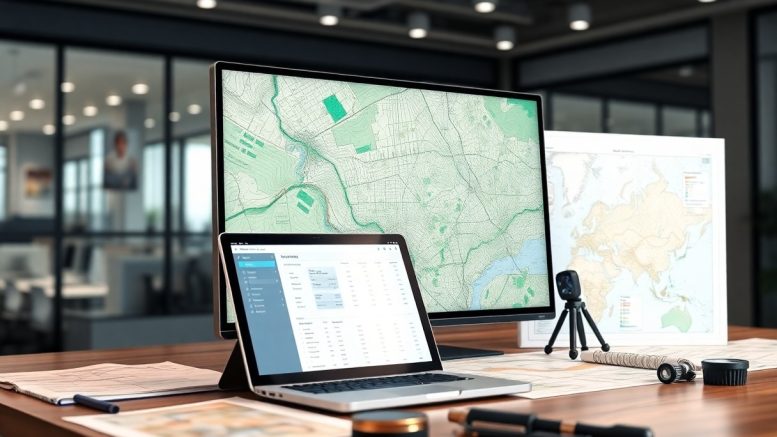Maps serve as vital tools in asset management, providing key geographical insights that enhance decision-making. By digitizing hard copy maps, you gain access to interactive, updated information that improves accuracy and efficiency in managing assets. This transition allows you to integrate various data layers, facilitating better analysis and visualization of your resources. Moreover, digital maps can be easily shared and collaborated on, streamlining communication within your team and stakeholders. Embracing this technology not only preserves historical data but also positions your asset management strategy for future success.
Transforming Analog to Digital: The Conversion Process
Converting hard copy maps to digital formats involves several key steps, ensuring the integrity and utility of your data. Initially, you need to choose the right scanning technology, which may include flatbed scanners for smaller maps or large-format printers for expansive cartographic materials. After scanning, advanced software tools are employed for image enhancement, transforming the raw digital images into accurate representations. This includes correcting distortions, optimizing resolution, and ensuring metadata is attached for context. The final stage is exporting your maps in compatible formats, suitable for integration into your asset management systems.
Tech Innovations Enabling Map Digitization
Recent innovations in technology have significantly streamlined the map digitization process. High-resolution scanners and automated imaging systems allow for quick and precise conversions, while advanced GIS software provides powerful tools for analyzing and manipulating spatial data. Machine learning algorithms enhance image recognition, making it easier to process and catalog features within your maps. Cloud storage solutions also facilitate easy access to digitized maps, enabling collaboration across teams and ensuring that your data is securely stored and readily available.
Best Practices for Accurate Data Preservation
Implementing best practices during the digitization process is vital for preserving the accuracy of your maps. Start by assessing the condition of each map to identify any damage that may require repairs before scanning. Utilize a calibrated scanner to ensure consistency in image quality and color fidelity. During the digitization process, incorporate rigorous checks for accuracy, such as comparing digitized data with the original maps. Finally, create comprehensive metadata that includes details about the source, conditions of use, and potential limitations to enhance the value of your digital maps.
To ensure accurate data preservation, focus on controlled environments during scanning to prevent dust and moisture exposure. Use archival-grade materials for storage, maintaining optimal temperature and humidity to protect original maps. Regularly back up digitized files across multiple locations, ideally using both physical hard drives and cloud storage. Implement a standardized naming and cataloging system for easy retrieval, allowing for seamless integration into your asset management workflows. Periodic reviews of the digitized maps will also help you identify any deterioration in quality over time, enabling timely updates.
Enhancing Data Accessibility and Usability
Digitizing hard copy maps transforms how you access and utilize data, making information seamlessly available at your fingertips. With GIS technology, you can overlay various data sets, conduct spatial analysis, and generate reports in real time. This newfound accessibility allows for efficient decision-making, enabling you to react quickly to changes in your assets and environment, thus optimizing operational efficiency. By integrating digitized maps into current software systems, you can present complex data visually, making it easier for your team to understand and interact with vital information.
Impacts on Multi-Departmental Collaboration
Improved access to digitized maps fosters collaboration among various departments, enhancing communication and synergy. With centralized data resources, teams from engineering to operations can align their strategies, making informed decisions based on a unified view of asset locations and conditions. This collaborative approach diminishes silos, streamlining workflows and increasing overall productivity. Shared map interfaces facilitate joint planning initiatives, where everyone, from field workers to executives, engages with real-time data, ensuring cohesive efforts across departments.
Streamlining Data Retrieval in Asset Management
Streamlined data retrieval enhances efficiency in asset management by reducing time spent searching for critical information. Digital mapping tools allow you to quickly locate assets, view their historical data, and analyze maintenance needs. The convenience of accessing vital maps and associated data instantly contributes to better resource allocation and proactive asset management. This process eliminates the traditional lag caused by manual searches, allowing for swifter responses to maintenance requests or inspections.
When information about assets is readily available through digitized maps, you reduce the likelihood of errors that can occur during data entry or retrieval. Imagine having mobile access to your asset maps in the field; you can instantly check the status of a site, review asset details, and quickly assess conditions. These capabilities not only improve your responsiveness but also empower your team to make data-driven decisions on the spot. This agility enhances operational effectiveness, allowing for better planning and execution of asset management strategies, ultimately leading to lowered costs and maximized functionality of assets.
Elevating Decision-Making Through Geographic Insights
Geographic insights gained from digitized maps can significantly enhance your decision-making processes. By visualizing data in relation to geographical locations, you can identify patterns, trends, and correlations that might otherwise remain hidden. This spatial analysis allows you to make informed decisions regarding resource allocation, risk assessment, and strategic planning, ultimately leading to improved asset management outcomes.
The Role of GIS in Modern Asset Management
Geographic Information Systems (GIS) play a pivotal role in modern asset management by integrating spatial data with relevant asset information. Through GIS, you can maintain up-to-date records, track asset locations, manage maintenance schedules, and analyze geographic trends. This creates a powerful tool for visualizing asset performance over time, enabling you to optimize operations and enhance service delivery.
Predictive Analytics and Its Benefits
Predictive analytics harnesses historical and current data to forecast future asset performance and identify potential issues before they arise. You can make proactive decisions regarding maintenance, investments, and resource allocation, leading to cost savings and improved operational efficiency.
Implementing predictive analytics allows you to leverage machine learning algorithms and statistical models to analyze trends and predict future asset behavior. For example, by examining historical maintenance records alongside environmental data, you can forecast when equipment is likely to fail, enabling you to schedule preventive maintenance and avoid costly downtime. Studies show organizations that utilize predictive analytics often reduce maintenance costs by up to 30% and enhance asset lifespan, demonstrating the potential for significant operational advantages in your asset management strategies.
Cost Efficiency: Reducing Long-Term Expenses
Shifting to digital map management significantly cuts long-term expenses, primarily by minimizing the costs associated with storage, physical wear, and the labor needed for manual updates. Eliminating the need for physical space to store hard copies and reducing the resources required for handling and maintaining these assets can yield substantial financial savings over time. Moreover, streamlined access to digital maps allows for quicker decision-making, further enhancing overall operational efficiency.
Comparing Physical vs. Digital Map Management Costs
| Physical Map Management Costs | Digital Map Management Costs |
| Storage and maintenance fees | Minimal server or software expenses |
| Labor-intensive updates | Automated updates |
| Decreased accessibility | Instant access from multiple devices |
Long-Term Savings Through Improved Resource Allocation
Improved resource allocation through digitized maps leads to significant savings by optimizing how you utilize staff and materials. With fast access to updated data, you can redirect personnel to more strategic tasks instead of manual map management. This shift reduces overtime costs and enhances productivity, allowing for better deployment of your workforce towards impactful projects. The efficiency gained translates to measurable savings in operational costs over the long haul.
Consider that companies utilizing digital asset management report up to 30% reduction in operational costs due to enhanced resource allocation. This includes less reliance on manual labor for data updates and reallocating the saved time to pressing initiatives that can drive revenue. Often, the initial investment in digitizing assets pays for itself within a few years, as you harness both immediate efficiency and long-term financial benefits.
Future-Proofing Asset Management Strategies
By digitizing hard copy maps, you bolster your asset management strategies against rapid changes in technology and market demands. These advances require adaptability, ensuring you remain competitive and efficient. A robust digital framework not only streamlines your operations but also enhances decision-making capabilities, allowing you to thrive in an ever-evolving landscape.
Adapting to Technological Advancements
Your asset management systems must evolve in response to emerging technologies, such as artificial intelligence and machine learning. Embracing digital maps enables you to leverage these tools for predictive analytics, optimizing maintenance schedules and resource allocation. Staying updated with these advancements strengthens your strategic positioning.
Preparing for Integration with IoT and Smart Technologies
Integrating IoT and smart technologies into your asset management framework enhances data collection and real-time monitoring. This approach leads to more informed decision-making and improved asset utilization. Digital maps serve as interactive interfaces, offering real-time data visualization and insights that drive efficient asset management practices.
With the integration of IoT devices, your asset management processes can gather data on asset performance, condition, and location with unprecedented accuracy. For instance, sensors can relay information back to your digital maps, providing a comprehensive overview of your assets’ status in real time. This synergy allows for proactive maintenance and rapid response to any issues, reducing downtime and enhancing overall operational efficiency. You can leverage this data to create more strategic asset deployment and management decisions, ensuring your operations remain agile and responsive to changing demands.
Conclusion
Conclusively, digitizing hard copy maps significantly enhances your asset management capabilities by providing real-time data access and improved accuracy. This transformation enables you to streamline operations, reduce costs, and make informed decisions quicker. By utilizing digital maps, you can easily integrate various data layers and visualize asset locations, leading to more efficient resource allocation. Adopting this approach not only modernizes your asset management practices but also empowers you to respond swiftly to changes in your environment.






Be the first to comment on "How Can Digitizing Hard Copy Maps Support Modern Asset Management?"